Previous issue | Next issue | Archive
Volume 14 (4); December, 2024 [Booklet] [Endnote XML for Agris]
|
|
Research Paper
The Combination of Attapulgite, Betaine, and Chromium with Curcumin on Lipid Metabolism in Laying Hens under Tropical Conditions
Muhshi HM, Mutia R, Sumiati S, Wardani WW, Akbar I, and Putri NDS.
J. World Poult. Res. 14(4): 331-342, 2024; pii: S2322455X2400034-14
DOI: https://dx.doi.org/10.36380/jwpr.2024.34
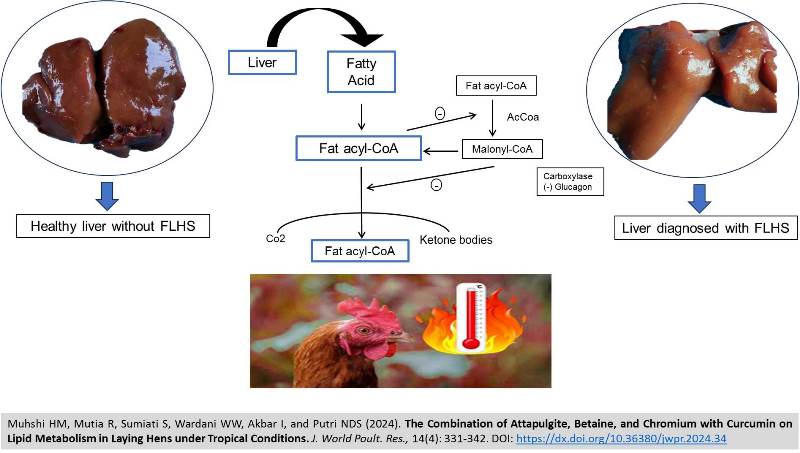 ABSTRACT: Liver health in laying hen is associated with lipid synthesis and metabolism. This study focused on oxidative parameters to maintain liver health and lipid metabolism in laying hens. The efficacy of curcumin as a herbal compound, combined with attapulgite, betaine, and organic chromium in a feed additive called Citrus XL, was evaluated in terms of its impact on lipid metabolism. This study involved 2000 ISA Brown strain laying hens aged 82-87 weeks. The heat stress index was calculated based on a temperature of 26.71 ± 1.11 oC and humidity of 83.21 ± 6.86 % in open-house cages with an 18-hour lighting period. This experiment included four treatments with five replications, including a basal diet with no Citrus XL (Control), a basal diet plus 0.5 kg/ton of Citrus XL, a basal diet plus 1.0 kg/ton of Citrus XL, and a basal diet plus 1.5 kg/ton of Citrus XL. To do so, blood biochemistry, fat content, liver score, malondialdehyde (MDA), and superoxide dismutase (SOD) levels were measured. The results indicated a significant increase in HDL levels as well as a reduction in LDL and MDA levels, liver scores, and egg yolk fat content. In conclusion, the treatment with 1.0 kg/ton of Citrus XL yielded the best results in terms of HDL, liver score, and liver MDA while Citrus XL treatment with 0.5 kg/ton produced the best results for LDL and yolk fat content.
ABSTRACT: Liver health in laying hen is associated with lipid synthesis and metabolism. This study focused on oxidative parameters to maintain liver health and lipid metabolism in laying hens. The efficacy of curcumin as a herbal compound, combined with attapulgite, betaine, and organic chromium in a feed additive called Citrus XL, was evaluated in terms of its impact on lipid metabolism. This study involved 2000 ISA Brown strain laying hens aged 82-87 weeks. The heat stress index was calculated based on a temperature of 26.71 ± 1.11 oC and humidity of 83.21 ± 6.86 % in open-house cages with an 18-hour lighting period. This experiment included four treatments with five replications, including a basal diet with no Citrus XL (Control), a basal diet plus 0.5 kg/ton of Citrus XL, a basal diet plus 1.0 kg/ton of Citrus XL, and a basal diet plus 1.5 kg/ton of Citrus XL. To do so, blood biochemistry, fat content, liver score, malondialdehyde (MDA), and superoxide dismutase (SOD) levels were measured. The results indicated a significant increase in HDL levels as well as a reduction in LDL and MDA levels, liver scores, and egg yolk fat content. In conclusion, the treatment with 1.0 kg/ton of Citrus XL yielded the best results in terms of HDL, liver score, and liver MDA while Citrus XL treatment with 0.5 kg/ton produced the best results for LDL and yolk fat content.
Keywords: Curcumin, Heat stress, Laying hens, Lipid metabolism, Liver
[Full text-PDF] [Crossref Metadata] [Scopus] [Export from ePrints]
|
|
Research Paper
Effects of in ovo Injection of Soursop (Annona muricata) Leaf Extract on Blood Profile, Immune Organs, and Intestinal Morphology of Noiler Chicks
Kuka TT, N’nanle O, Karou S, Tona K, and Bakoma B.
J. World Poult. Res. 14(4): 343-350, 2024; pii: S2322455X2400035-14
DOI: https://dx.doi.org/10.36380/jwpr.2024.35
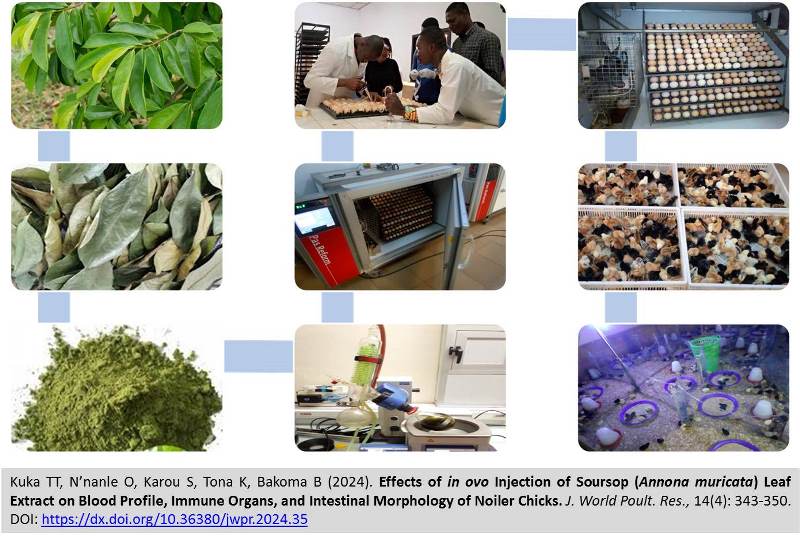 ABSTRACT: Plant extracts in poultry production are widely recognized for their significant benefits in improving productive performance. Specifically, the in ovo administration of soursop leaf extract (SLE) shows promise in improving the health and productivity of Noiler chickens. This study aimed to provide valuable insights into the health of the chicks and evaluate the effectiveness and safety of in ovo SLE in poultry production by examining the blood profile, internal organs, and intestinal morphology of Noiler chickens. For this experiment, 640 hatching eggs were incubated and randomly divided into four experimental groups, including 0.25 µg SLE, 0.5 µg SLE, 0.75 µg SLE, and a non-injected control group. Three treatment groups received a direct injection of 0.2 ml of the respective SLE concentrations into the air cells of the eggs on the 18th day of incubation. After hatching, chickens from each group were divided into five replicates of 15 chicks each and raised using a completely randomized design. At ten days of age, blood samples were collected from two chicks per replicate for hematology and serum analysis. Two chicks per replicate were sacrificed on day 10 to assess the internal organs and intestinal morphology. The results showed no significant changes in hematological parameters, serum biochemistry, and internal organs in all groups. The soursop leaf extract groups had markedly longer villi, deeper crypts, and thicker muscular walls compared to the control group. In conclusion, the in ovo injection of soursop leaf extract at 0.75 µg improved intestinal health by enhancing the intestinal surface structures in Noiler chickens.
ABSTRACT: Plant extracts in poultry production are widely recognized for their significant benefits in improving productive performance. Specifically, the in ovo administration of soursop leaf extract (SLE) shows promise in improving the health and productivity of Noiler chickens. This study aimed to provide valuable insights into the health of the chicks and evaluate the effectiveness and safety of in ovo SLE in poultry production by examining the blood profile, internal organs, and intestinal morphology of Noiler chickens. For this experiment, 640 hatching eggs were incubated and randomly divided into four experimental groups, including 0.25 µg SLE, 0.5 µg SLE, 0.75 µg SLE, and a non-injected control group. Three treatment groups received a direct injection of 0.2 ml of the respective SLE concentrations into the air cells of the eggs on the 18th day of incubation. After hatching, chickens from each group were divided into five replicates of 15 chicks each and raised using a completely randomized design. At ten days of age, blood samples were collected from two chicks per replicate for hematology and serum analysis. Two chicks per replicate were sacrificed on day 10 to assess the internal organs and intestinal morphology. The results showed no significant changes in hematological parameters, serum biochemistry, and internal organs in all groups. The soursop leaf extract groups had markedly longer villi, deeper crypts, and thicker muscular walls compared to the control group. In conclusion, the in ovo injection of soursop leaf extract at 0.75 µg improved intestinal health by enhancing the intestinal surface structures in Noiler chickens.
Keywords: Hematology, Internal organ, In ovo, Intestinal morphology, Noiler chicken, Soursop Leaf Extract
[Full text-PDF] [Crossref Metadata] [Scopus] [Export from ePrints]
|
|
Research Paper
Effects of Cactus Flour (Opuntia ficus-indica) on Productive Performance and Eggshell Quality of Laying Hens
Juárez A, Gutiérrez E, Villalba C, and Ordaz G.
J. World Poult. Res. 14(4): 351-360, 2024; pii: S2322455X2400036-14
DOI: https://dx.doi.org/10.36380/jwpr.2024.36
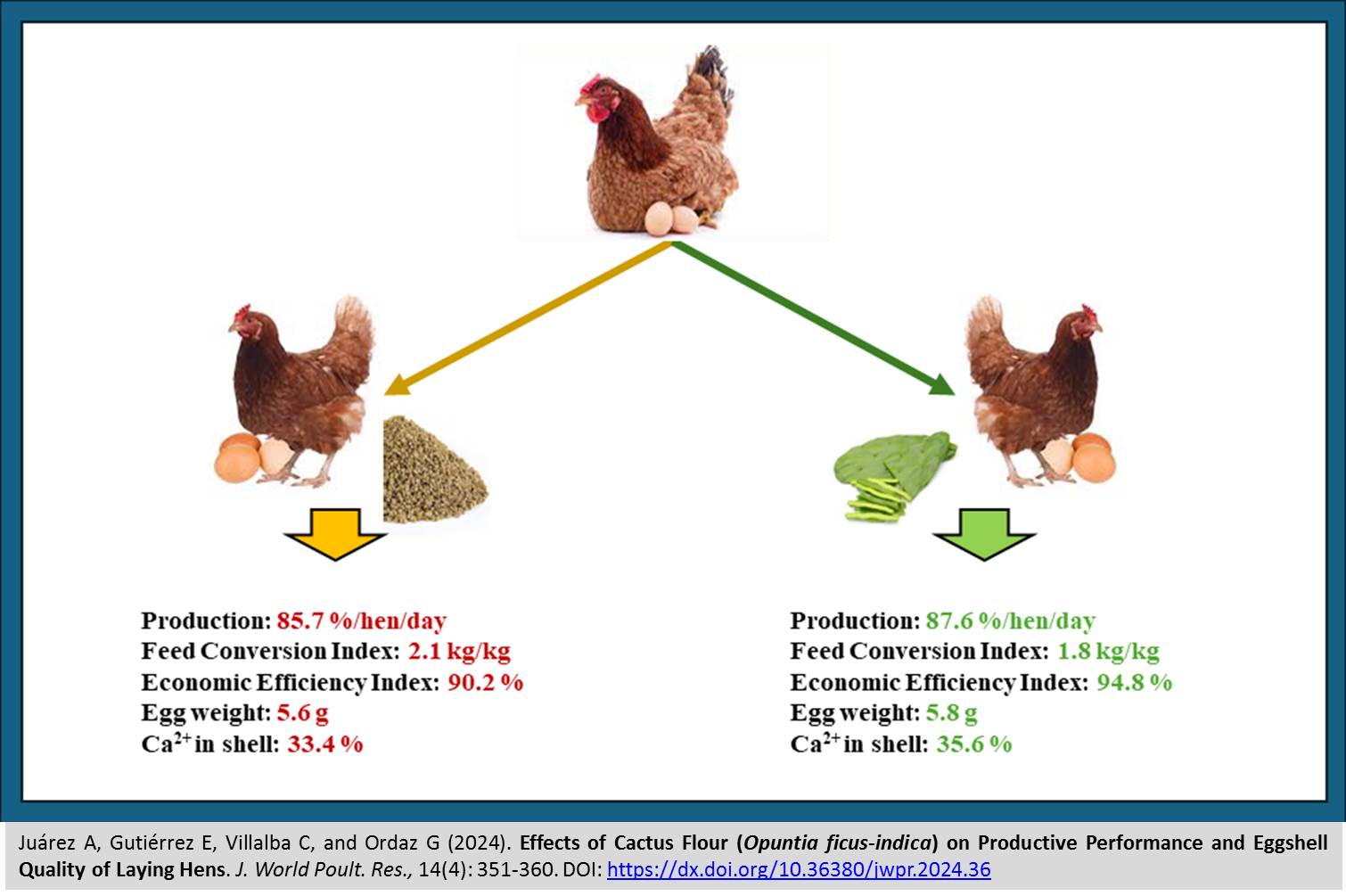 ABSTRACT: The poultry industry plays a crucial role in the production of animal proteins for human consumption and generating sources of employment. Thus, it is essential to explore effective strategies to enhance both the productivity of laying hens and the quality of their products, particularly eggshell quality, due to its significant economic implications for the poultry sector. This study aimed to evaluate the effects of cactus flour (CF; Opuntia ficus-indica) on the productive performance and eggshell quality of laying hens. Twenty-four Rhode Island Red laying hens were randomly divided into two groups (n = 12 experimental units -hens-/group) consisting of a control group and another fed CF (1% of the diet volume). The variables assessed included initial and final weight, weight gain, feed and calcium intake, egg production, egg mass, feed conversion index/kg of egg, economic efficiency index, egg weight, shell weight, shell thickness, shell percentage, and calcium levels in eggshells and excreta (daytime and nighttime). The addition of CF in the diet affected the final weight of hens, with the CF-fed hens (2.1 kg) being heavier than the control (1.9 kg). Egg production was higher in the CF-fed hens than in the control hens. Additionally, the mean egg weight was higher (68.5 g) in the CF-fed hens than in the control (62.2 g). The feed conversion index was lower in the CF-fed hens (2.1 kg/kg) than in the control (1.8 kg/kg). The economic efficiency index was higher in the CF-fed hens (94.8 %) than in the control (90.2 %). Eggshell weight (5.8 g), thickness (0.31 mm), and calcium levels (35.6 %) were significantly higher in the CF-fed hens than in the control (5.1 g, 0.27 mm, and 33.4 % for eggshell weight, thickness, and calcium levels, respectively). In conclusion, the inclusion of CF in the diet of laying hens improved the productive indicators and eggshell quality, thereby enhancing economic efficiency.
ABSTRACT: The poultry industry plays a crucial role in the production of animal proteins for human consumption and generating sources of employment. Thus, it is essential to explore effective strategies to enhance both the productivity of laying hens and the quality of their products, particularly eggshell quality, due to its significant economic implications for the poultry sector. This study aimed to evaluate the effects of cactus flour (CF; Opuntia ficus-indica) on the productive performance and eggshell quality of laying hens. Twenty-four Rhode Island Red laying hens were randomly divided into two groups (n = 12 experimental units -hens-/group) consisting of a control group and another fed CF (1% of the diet volume). The variables assessed included initial and final weight, weight gain, feed and calcium intake, egg production, egg mass, feed conversion index/kg of egg, economic efficiency index, egg weight, shell weight, shell thickness, shell percentage, and calcium levels in eggshells and excreta (daytime and nighttime). The addition of CF in the diet affected the final weight of hens, with the CF-fed hens (2.1 kg) being heavier than the control (1.9 kg). Egg production was higher in the CF-fed hens than in the control hens. Additionally, the mean egg weight was higher (68.5 g) in the CF-fed hens than in the control (62.2 g). The feed conversion index was lower in the CF-fed hens (2.1 kg/kg) than in the control (1.8 kg/kg). The economic efficiency index was higher in the CF-fed hens (94.8 %) than in the control (90.2 %). Eggshell weight (5.8 g), thickness (0.31 mm), and calcium levels (35.6 %) were significantly higher in the CF-fed hens than in the control (5.1 g, 0.27 mm, and 33.4 % for eggshell weight, thickness, and calcium levels, respectively). In conclusion, the inclusion of CF in the diet of laying hens improved the productive indicators and eggshell quality, thereby enhancing economic efficiency.
Keywords: Egg production, Cactus flour, Calcium, Laying hens, Poultry farming
[Full text-PDF] [Crossref Metadata] [Scopus] [Export from ePrints]
|
|
Antibiotic Resistance Pattern of Escherichia coli Isolated from Layer Chicken in Bali-Indonesia |
Research Paper
Antibiotic Resistance Pattern of Escherichia coli Isolated from Layer Chicken in Bali-Indonesia
Besung INK, Sudipa PH, Suarjana IGK, and Suwiti NK.
J. World Poult. Res. 14(4): 361-368, 2024; pii: S2322455X2400037-14
DOI: https://dx.doi.org/10.36380/jwpr.2024.37
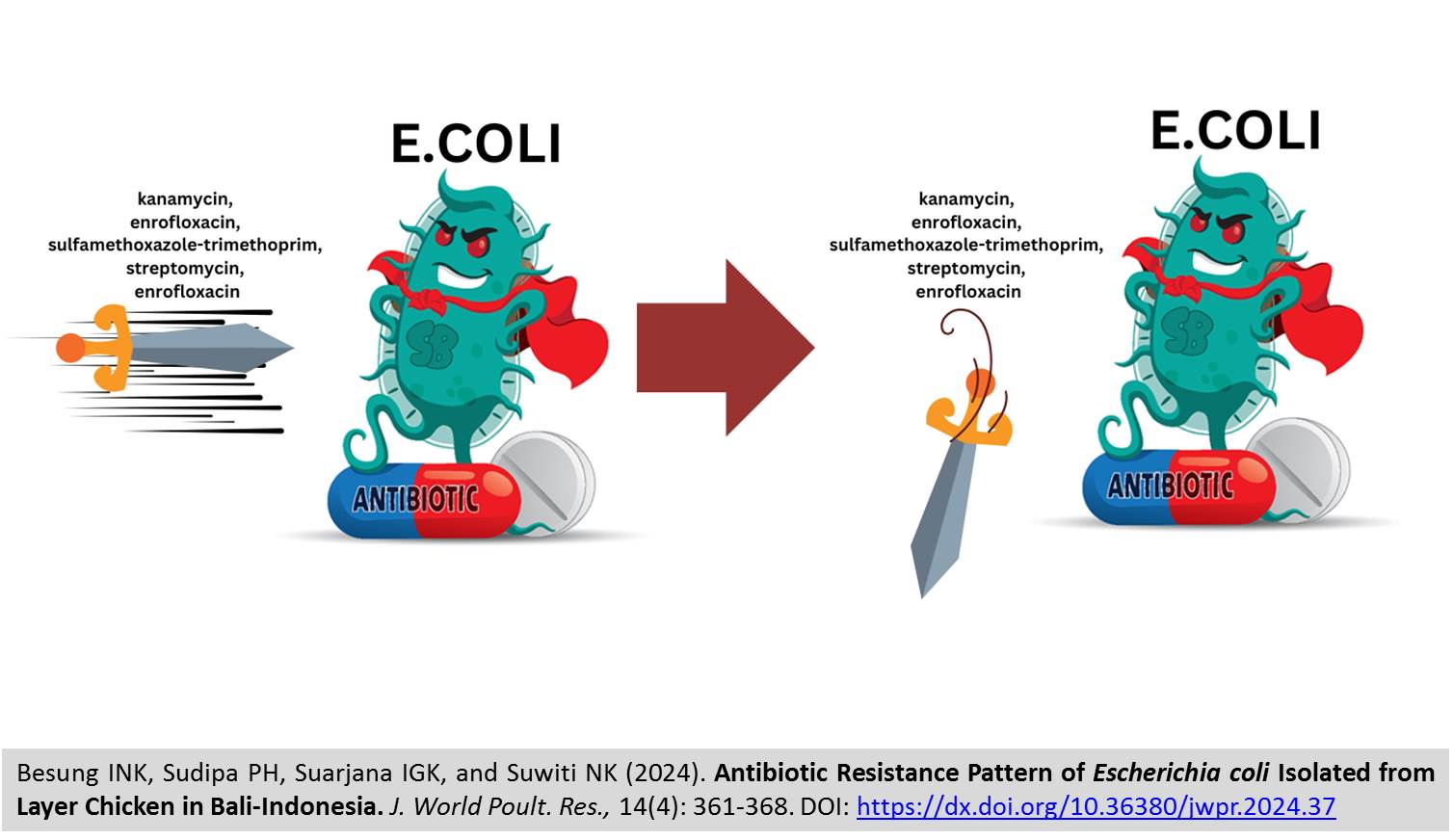 ABSTRACT: Antibiotics have been used as growth promoters in the poultry industry worldwide, which might lead to the emergence of anti-microbial resistant bacterial strains. Theoretically, older animals should have been exposed to antibiotics and anti-microbial resistant (AMR) strains for longer periods, which may result in the discovery of more resistant strains. The present study aimed to evaluate the antibiotic resistance of Escherichia coli isolated from fecal samples of layer chicken that showed signs of watery diarrhea. In the current study, 134 fecal samples were taken from the layer chicken farms in Penebel village, Tabanan District, Bali, Indonesia. The chickens were classified into three groups including Group 1 under 7 days of age, group 2 aged 7-30 days, and Group 3 chickens older than one month. The samples were cultured in Eosin Methylene Blue agar. The suspected colonies were stained, and subjected to biochemical tests. Escherichia coli-positive colonies were subjected to a bacteria sensitivity test using multiple antibiotic discs. The result demonstrated multi-drug resistance (MDR) of Escherichia coli, while the isolated Escherichia coli was resistant to the most common antibiotics in layer farms in the study area including kanamycin, enrofloxacin, sulfamethoxazole-trimethoprim, streptomycin, and enrofloxacin. In addition, the present study confirmed that although all sample groups were sensitive to bacitracin, oxytetracycline, and clindamycin, they were resistant to sulfamethoxazole-trimethoprim, kanamycin, and ampicillin.
ABSTRACT: Antibiotics have been used as growth promoters in the poultry industry worldwide, which might lead to the emergence of anti-microbial resistant bacterial strains. Theoretically, older animals should have been exposed to antibiotics and anti-microbial resistant (AMR) strains for longer periods, which may result in the discovery of more resistant strains. The present study aimed to evaluate the antibiotic resistance of Escherichia coli isolated from fecal samples of layer chicken that showed signs of watery diarrhea. In the current study, 134 fecal samples were taken from the layer chicken farms in Penebel village, Tabanan District, Bali, Indonesia. The chickens were classified into three groups including Group 1 under 7 days of age, group 2 aged 7-30 days, and Group 3 chickens older than one month. The samples were cultured in Eosin Methylene Blue agar. The suspected colonies were stained, and subjected to biochemical tests. Escherichia coli-positive colonies were subjected to a bacteria sensitivity test using multiple antibiotic discs. The result demonstrated multi-drug resistance (MDR) of Escherichia coli, while the isolated Escherichia coli was resistant to the most common antibiotics in layer farms in the study area including kanamycin, enrofloxacin, sulfamethoxazole-trimethoprim, streptomycin, and enrofloxacin. In addition, the present study confirmed that although all sample groups were sensitive to bacitracin, oxytetracycline, and clindamycin, they were resistant to sulfamethoxazole-trimethoprim, kanamycin, and ampicillin.
Keywords: Antibiotic resistance, Bali, Colibacillosis, Escherichia coli, Layer chicken
[Full text-PDF] [Crossref Metadata] [Scopus] [Export from ePrints]
|
|
Research Paper
Effects of Fermented and Non-fermented Green Seaweed Supplementation on Performance, Caecal Bacterial Population, and Blood Constituents of Japanese Quails
Abu Hafsa SH, Abd-Ellatif S, Eid Farag ME, Breakaa MA, Razik ElShA, and Hassan AA.
J. World Poult. Res. 14(4): 369-381, 2024; pii: S2322455X2400038-14
DOI: https://dx.doi.org/10.36380/jwpr.2024.38
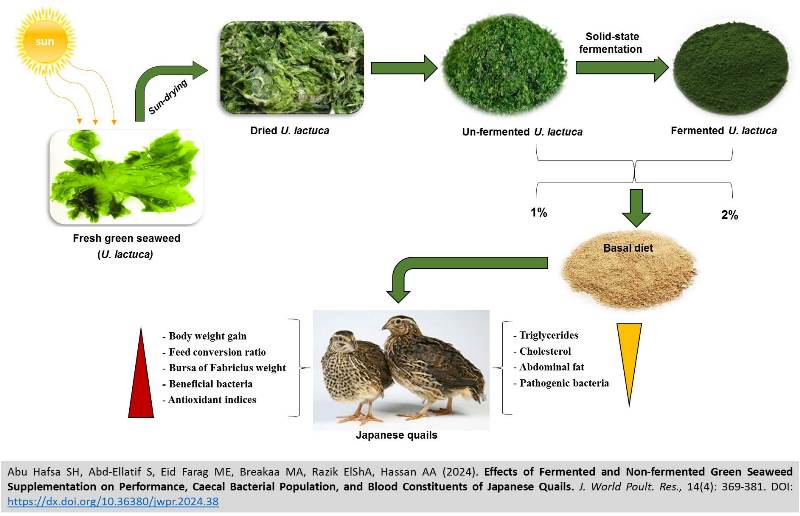 ABSTRACT: Green Seaweeds are a valuable feedstock that can be utilized in poultry feed. Due to their recalcitrant polysaccharide structure, their use is still limited in poultry farming. This structure can be broken by a biotechnological approach such as solid-state fermentation (SSF) such as Trichoderma reesei, which simultaneously increases the nutritional value of the biomass. The current study aimed to investigate the effect of supplementation of fermented and non-fermented green seaweed (Ulva lactuca) on growth performance, nutrient digestibility, carcass characteristics, caecal microbiota, serum biochemistry, and antioxidant status in growing Japanese quails. Japanese quails (n = 375; one day old) were divided into five groups, with three replicates per group (25 quails in each replication). The quails were fed with five experimental diets, namely a control diet (basal diet without supplement), a basal diet supplemented with 1% and 2% green seaweed (GS) as well as 1% and 2% fermented green seaweed (FGS) for 42 days. The results showed that the groups fed FGS had a greater body weight gain and better feed conversion ratio than the other groups. The FGS groups showed the highest digestibility of crude protein and crude fiber, followed by the GS groups. FGS supplementation decreased abdominal fat percentage while increasing the bursa of Fabricius weight. The count of Lactobacillus was significantly increased in quails fed either GS or FGS, while Clostridium perfringens and Escherichia coli were decreased. The green seaweed-fed groups had significantly greater total protein, albumin, and globulin levels than the control group. Total lipids, triglycerides, cholesterol, HDL, and LDL were decreased in quails-fed diets containing 1% and 2% FGS. The quails in FGS diet groups had higher levels of total antioxidant capacity, catalase, and superoxide dismutase than the other groups, but lower levels of MDA. In conclusion, adding up to 2% fermented Ulva lactuca to the basal diet of Japanese quail promotes the growth and health of quails.
ABSTRACT: Green Seaweeds are a valuable feedstock that can be utilized in poultry feed. Due to their recalcitrant polysaccharide structure, their use is still limited in poultry farming. This structure can be broken by a biotechnological approach such as solid-state fermentation (SSF) such as Trichoderma reesei, which simultaneously increases the nutritional value of the biomass. The current study aimed to investigate the effect of supplementation of fermented and non-fermented green seaweed (Ulva lactuca) on growth performance, nutrient digestibility, carcass characteristics, caecal microbiota, serum biochemistry, and antioxidant status in growing Japanese quails. Japanese quails (n = 375; one day old) were divided into five groups, with three replicates per group (25 quails in each replication). The quails were fed with five experimental diets, namely a control diet (basal diet without supplement), a basal diet supplemented with 1% and 2% green seaweed (GS) as well as 1% and 2% fermented green seaweed (FGS) for 42 days. The results showed that the groups fed FGS had a greater body weight gain and better feed conversion ratio than the other groups. The FGS groups showed the highest digestibility of crude protein and crude fiber, followed by the GS groups. FGS supplementation decreased abdominal fat percentage while increasing the bursa of Fabricius weight. The count of Lactobacillus was significantly increased in quails fed either GS or FGS, while Clostridium perfringens and Escherichia coli were decreased. The green seaweed-fed groups had significantly greater total protein, albumin, and globulin levels than the control group. Total lipids, triglycerides, cholesterol, HDL, and LDL were decreased in quails-fed diets containing 1% and 2% FGS. The quails in FGS diet groups had higher levels of total antioxidant capacity, catalase, and superoxide dismutase than the other groups, but lower levels of MDA. In conclusion, adding up to 2% fermented Ulva lactuca to the basal diet of Japanese quail promotes the growth and health of quails.
Keywords: Antioxidant status, Caecal microbiota, Fermentation, Green seaweed, Performance, Lipid profile, Japanese quail
[Full text-PDF] [Crossref Metadata] [Scopus] [Export from ePrints]
|
|
Research Paper
Epidemiological Investigation of Eimeria Species and Effectiveness of Togolese Medicinal Plants Used Against Chicken Coccidiosis
Tchodo FG, Dakpogan HB, Gambogou B, N'nanle O, Adjei-Mensah B, Tona K, and Bakoma B.
J. World Poult. Res. 14(4): 382-398, 2024; pii: S2322455X2400039-14
DOI: https://dx.doi.org/10.36380/jwpr.2024.39
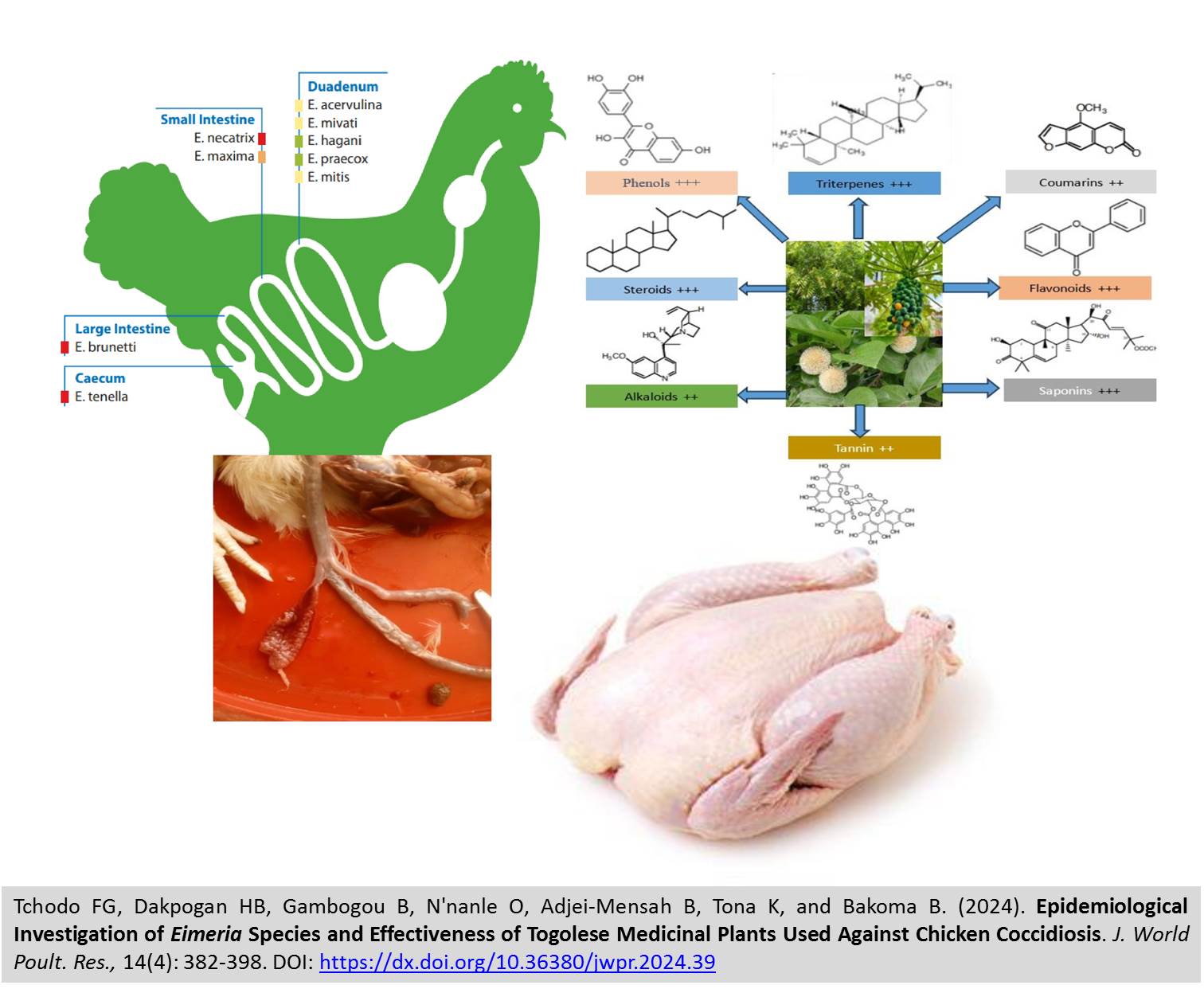 ABSTRACT: Eimeria species cause coccidiosis, a poultry disease that occurs worldwide. Infection is linked to decreased feed efficiency and body weight increase. The present study aimed to assess the prevalence of coccidian species in Togolese poultry farms and evaluate the anticoccidial efficacy of three local medicinal plants. From July to September 2023, two hundred and ninety-five fecal samples were randomly collected using a cross-sectional observational study in the maritime region of Togo, specifically in Vo, Lacs, Zio, and Grand-Lomé districts. Data on risk factors were collected through an interview with the poultry farmers. All fecal samples collected were subjected to Eimeria oocyst counting using the standard McMaster technique. The anticoccidial activity of the extract of Azadirachta indica leaves Carica papaya seeds, and Sarcocephalus latifolius roots in a completely randomized design was evaluated on 23-day-old male Isa brown chicks infected with 30.104 oocysts. Body weight gain, feed efficiency, lesion score, proportion of bloody droppings, anticoccidial index, and excretion of coccidia oocysts were assessed. The results revealed an overall prevalence of 39.66% (117/295) for coccidiosis, with 75% of positive samples having fewer than 10,000 oocysts/g. The logistic regression test indicated that the interval between two anticoccidial prophylaxis applications, age, management, and breed were significant risk factors associated with coccidial infection, with young chicks (≤ 8 weeks) being 5.66 times more susceptible than those older ones (8 weeks) with 0.86 as an odd ratio. Six Eimeria species were identified, with E. maxima (54.17%), E. brunetti (33.33%), and E. tenella (25%) being the most common. The anticoccidial efficacy of Azadirachta indica leaves, Carica papaya seeds Sarcocephalus latifolius roots extract, and amprolium was demonstrated by a reduction in lesion scores, bloody diarrhea, and oocysts per gram in feces (OPG) as well as an improvement in body weight, feed conversion ratio, and production efficiency factor when compared to infected and untreated groups. The anticoccidial index was marked in the chickens treated with Sarcocephalus latifolius roots extract (170) and amprolium (176). The findings of this large-scale epidemiological study and anticoccidial efficacy tests revealed that these Togolese medicinal plants can be sustainable and cost-effective strategies for coccidiosis control.
ABSTRACT: Eimeria species cause coccidiosis, a poultry disease that occurs worldwide. Infection is linked to decreased feed efficiency and body weight increase. The present study aimed to assess the prevalence of coccidian species in Togolese poultry farms and evaluate the anticoccidial efficacy of three local medicinal plants. From July to September 2023, two hundred and ninety-five fecal samples were randomly collected using a cross-sectional observational study in the maritime region of Togo, specifically in Vo, Lacs, Zio, and Grand-Lomé districts. Data on risk factors were collected through an interview with the poultry farmers. All fecal samples collected were subjected to Eimeria oocyst counting using the standard McMaster technique. The anticoccidial activity of the extract of Azadirachta indica leaves Carica papaya seeds, and Sarcocephalus latifolius roots in a completely randomized design was evaluated on 23-day-old male Isa brown chicks infected with 30.104 oocysts. Body weight gain, feed efficiency, lesion score, proportion of bloody droppings, anticoccidial index, and excretion of coccidia oocysts were assessed. The results revealed an overall prevalence of 39.66% (117/295) for coccidiosis, with 75% of positive samples having fewer than 10,000 oocysts/g. The logistic regression test indicated that the interval between two anticoccidial prophylaxis applications, age, management, and breed were significant risk factors associated with coccidial infection, with young chicks (≤ 8 weeks) being 5.66 times more susceptible than those older ones (8 weeks) with 0.86 as an odd ratio. Six Eimeria species were identified, with E. maxima (54.17%), E. brunetti (33.33%), and E. tenella (25%) being the most common. The anticoccidial efficacy of Azadirachta indica leaves, Carica papaya seeds Sarcocephalus latifolius roots extract, and amprolium was demonstrated by a reduction in lesion scores, bloody diarrhea, and oocysts per gram in feces (OPG) as well as an improvement in body weight, feed conversion ratio, and production efficiency factor when compared to infected and untreated groups. The anticoccidial index was marked in the chickens treated with Sarcocephalus latifolius roots extract (170) and amprolium (176). The findings of this large-scale epidemiological study and anticoccidial efficacy tests revealed that these Togolese medicinal plants can be sustainable and cost-effective strategies for coccidiosis control.
Keywords: Anticoccidial drug sensibility, Coccidiosis, Prevalence, Risk factor, Togo
[Full text-PDF] [Crossref Metadata] [Scopus] [Export from ePrints]
|
|
Research Paper
Performance of Quail (Coturnix Japonica) Fed Diets with Fish Meal Substituted by Catfish Offal Flour (Pangaius hypopthalmus)
Erwan E, Pratama R, Mirdhayati I, Prameswara JA, Husti I, and Emadi M.
J. World Poult. Res. 14(4): 399-403, 2024; pii: S2322455X2400040-14
DOI: https://dx.doi.org/10.36380/jwpr.2024.40
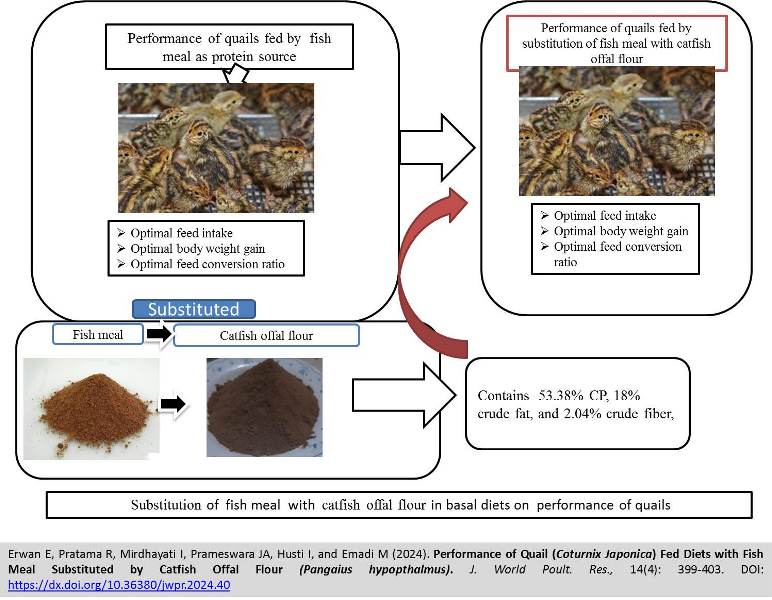 ABSTRACT: Catfish offal flour (COF; Pangaius hypopthalmus) has the potential to replace fish meal (FM) due to its high crude protein content. The present study aimed to investigate the effects of substituting FM with COF in basal diets on food intake (FI), body weight gain (BWG), and feed conversion ratio (FCR) in quails. A total of 100 male quails were randomly assigned to five treatment groups, each with four replicates. The treatment groups were fed with basal diet + 0% COF and 100% FM (T0), basal diet + 25% COF and 75% FM (T1), basal diet + 50% COF and 50% FM (T2), basal diet + 75% COF and 25% FM (T3), and basal diet + 100% COF and 0% FM (T4). Feed intake, BWG, and FCR were measured from 0 to 35 days of age. The findings indicated that substituting FM with COF up to 100% did not significantly affect FI, BWG, and FCR. It can be concluded that COF has the potential to replace FM in basal diets while maintaining performance in quails.
ABSTRACT: Catfish offal flour (COF; Pangaius hypopthalmus) has the potential to replace fish meal (FM) due to its high crude protein content. The present study aimed to investigate the effects of substituting FM with COF in basal diets on food intake (FI), body weight gain (BWG), and feed conversion ratio (FCR) in quails. A total of 100 male quails were randomly assigned to five treatment groups, each with four replicates. The treatment groups were fed with basal diet + 0% COF and 100% FM (T0), basal diet + 25% COF and 75% FM (T1), basal diet + 50% COF and 50% FM (T2), basal diet + 75% COF and 25% FM (T3), and basal diet + 100% COF and 0% FM (T4). Feed intake, BWG, and FCR were measured from 0 to 35 days of age. The findings indicated that substituting FM with COF up to 100% did not significantly affect FI, BWG, and FCR. It can be concluded that COF has the potential to replace FM in basal diets while maintaining performance in quails.
Keywords: Catfish offal flour, Body weight gain, Feed intake, Feed conversion ratio, Quail
[Full text-PDF] [Crossref Metadata] [Scopus] [Export from ePrints]
|
|
Research Paper
Assessing the Productivity of BLRI-Developed Native Ducks at the Community Level Compared to Indigenous Ducks in Conventional Farming Systems
Islam S, Islam MA, Sultana S, Islam R, Rahman MH, and Khatun R.
J. World Poult. Res. 14(4): 404-417, 2024; pii: S2322455X2400041-14
DOI: https://dx.doi.org/10.36380/jwpr.2024.41
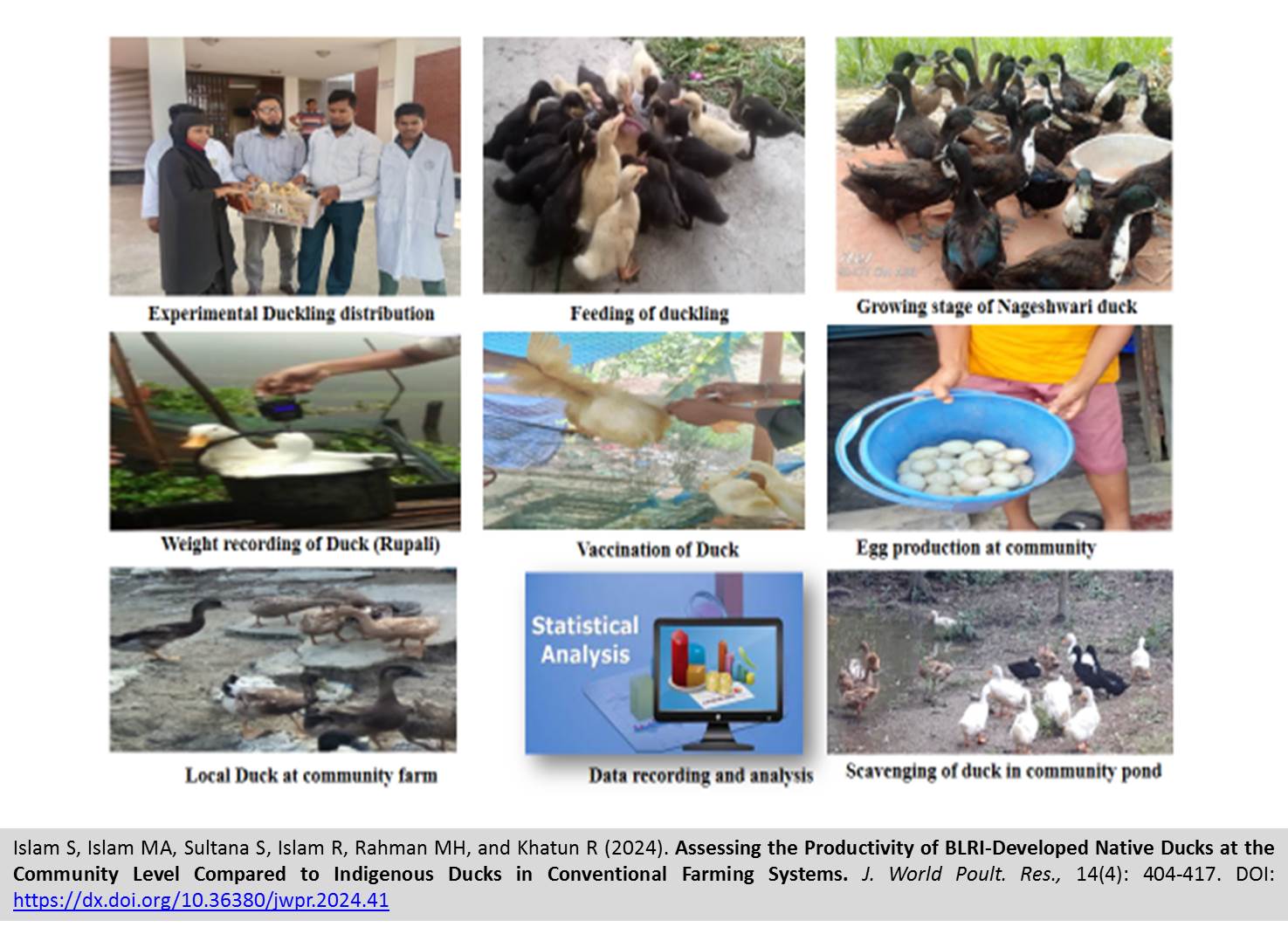 ABSTRACT: Duck farming is a profitable business in low-lying areas of Bangladesh. The present study aimed to disseminate Bangladesh Livestock Research Institute (BLRI) developed native ducks BLRI-1(Rupali) and BLRI-2 (Nageswari) and validate their production ability compared to indigenous ducks under existing farming conditions in Bhanga upazila of Faridpur. An experiment was done at the community level where 45 farmers were selected based on their duck type. Data on the productive potentials of BLRI-developed native ducks were recorded and compared with the local germplasm of ducks. Among 45 duck-rearing farmers, with an average age of 38.58 years and farming experience of 12.38 years. Ducks were raised under scavenging conditions where 82.2% of farmers used separate duck houses and regular house cleaning was practiced by 68.89% of farmers. Ducks were consistently fed paddy, rice, and rice bran whereas 82.2% of farmers provided supplement feed with duckweed, and 15.6% supplied ready-made feed. The highest growth performance was observed for Rupali ducks growing to 1505.62 g by 24 weeks, compared to 1486.07 g for Nagesawri ducks. The highest egg production was 192.00 ± 5.70 eggs in Nageswari ducks followed by 181.33 ± 7.55 eggs for Rupali. Statistically significant differences were observed in adult male and female weights, eggs per clutch, and egg weight among the three breeds. Most of the farmer (84.4%) vaccinate their duck, against Duck Plague and Duck Cholera. The highest incidences of Duck Plague and Duck Cholera were observed in Native duck farms in comparison to BLRI-developed duck farms. Farmers obtained the highest Net income 8149.00 BDT (68.04 USD) and Benefit-Cost Ratio (BCR) of 1.60 in Rupali ducks compared to the Indigenous ducks at 1.30 whereas the overall BCR in duck rearing was 1.49. Major constraints regarding duck farming were disease outbreaks (73.3%) and high feed prices (64.4%). Thus, the study highlighted the significant variations in the performance and economic viability of ducks and emphasized farmers' training and breed-specific management strategies such as improved housing; feeding, and disease management practices to boost the profitability of duck farming.
ABSTRACT: Duck farming is a profitable business in low-lying areas of Bangladesh. The present study aimed to disseminate Bangladesh Livestock Research Institute (BLRI) developed native ducks BLRI-1(Rupali) and BLRI-2 (Nageswari) and validate their production ability compared to indigenous ducks under existing farming conditions in Bhanga upazila of Faridpur. An experiment was done at the community level where 45 farmers were selected based on their duck type. Data on the productive potentials of BLRI-developed native ducks were recorded and compared with the local germplasm of ducks. Among 45 duck-rearing farmers, with an average age of 38.58 years and farming experience of 12.38 years. Ducks were raised under scavenging conditions where 82.2% of farmers used separate duck houses and regular house cleaning was practiced by 68.89% of farmers. Ducks were consistently fed paddy, rice, and rice bran whereas 82.2% of farmers provided supplement feed with duckweed, and 15.6% supplied ready-made feed. The highest growth performance was observed for Rupali ducks growing to 1505.62 g by 24 weeks, compared to 1486.07 g for Nagesawri ducks. The highest egg production was 192.00 ± 5.70 eggs in Nageswari ducks followed by 181.33 ± 7.55 eggs for Rupali. Statistically significant differences were observed in adult male and female weights, eggs per clutch, and egg weight among the three breeds. Most of the farmer (84.4%) vaccinate their duck, against Duck Plague and Duck Cholera. The highest incidences of Duck Plague and Duck Cholera were observed in Native duck farms in comparison to BLRI-developed duck farms. Farmers obtained the highest Net income 8149.00 BDT (68.04 USD) and Benefit-Cost Ratio (BCR) of 1.60 in Rupali ducks compared to the Indigenous ducks at 1.30 whereas the overall BCR in duck rearing was 1.49. Major constraints regarding duck farming were disease outbreaks (73.3%) and high feed prices (64.4%). Thus, the study highlighted the significant variations in the performance and economic viability of ducks and emphasized farmers' training and breed-specific management strategies such as improved housing; feeding, and disease management practices to boost the profitability of duck farming.
Keywords: Benefit-cost ratio, BLRI duck, Disease outbreak, Growth performance, Native duck, Profitability
[Full text-PDF] [Crossref Metadata] [Scopus] [Export from ePrints]
|
|
Research Paper
Effects of Layer Breeder Age and Early Hypoxic Stimulation (ED 7-9) of the Chorioallantois Membrane on Eggshell Decalcification, Neovascularization of Heart Tissue, Mineralization and Morphometrics of Hatchlings
Agbehadzi RK, Sasu P, Adjei-Mensah B, Dassidi N, Kouame YAE, Koranteng AA-a, Meteyake HT, Hamidu JA, and Tona K.
J. World Poult. Res. 14(4): 418-438, 2024; pii: S2322455X2400042-14
DOI: https://dx.doi.org/10.36380/jwpr.2024.42
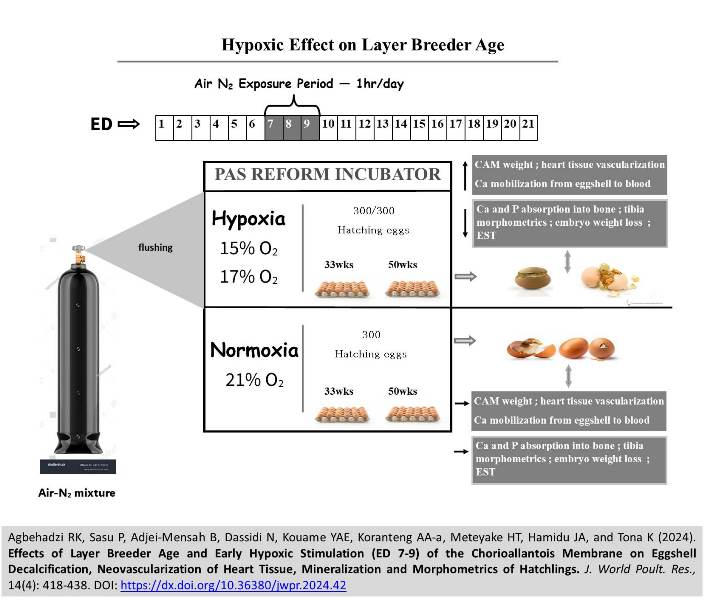 ABSTRACT: Oxygen concentration (O₂) during incubation is crucial for embryo development, and hypoxic conditions can influence phenotypic plasticity in poultry. Although low O2 (hypoxia) can be detrimental, it may also promote adaptive responses. Breeder age, a known genetic determinant of egg quality and embryonic development, is likely to interact with O₂ levels during incubation, however, this relationship remains understudied in layer breeders. This study examined how layer breeder age and reduced oxygen (O₂) levels during early embryonic development affect various factors, including eggshell decalcification (Dcal-SHL), chorioallantoic membrane (CAM) weight, heart tissue vascularization, egg weight loss (EWL), eggshell temperature (EST), and calcium (Ca) and phosphorus (P) content in bone and blood and tibia and femur morphometrics. A total of 900 eggs from 33 and 50-week-old ISA brown layer breeders were incubated in a 2x3 factorial design with O₂ levels of 15%, 17% (hypoxic), and 21% (control). Oxygen was reduced for 1hr/day from embryonic days (ED) 7-9 using air-N₂ flushing. Results showed increased CAM weight and heart tissue vascularization under hypoxia, especially in older breeders (50 weeks). Hypoxic conditions (15% and 17% O₂) reduced embryo weight loss and eggshell temperature compared to controls during the post-exposure phase (ED 15-18). There was an interaction between breeder age and O₂ levels on mineral absorption, with reduced oxygen leading to lower Ca and P absorption in bones, higher eggshell P retention, and decreased tibia morphometrics (weight, length, diameter, and seedor index) in hatchlings. Additionally, CAM weight correlated negatively with Dcal-SHL Ca at 15% O₂. The study concluded that reduced oxygen during early embryonic development increases CAM weight, heart neovascularization, and Ca mobilization from eggshell to blood. However, older flocks exhibited reduced Ca transfer to bones, likely due to homeostatic imbalance.
ABSTRACT: Oxygen concentration (O₂) during incubation is crucial for embryo development, and hypoxic conditions can influence phenotypic plasticity in poultry. Although low O2 (hypoxia) can be detrimental, it may also promote adaptive responses. Breeder age, a known genetic determinant of egg quality and embryonic development, is likely to interact with O₂ levels during incubation, however, this relationship remains understudied in layer breeders. This study examined how layer breeder age and reduced oxygen (O₂) levels during early embryonic development affect various factors, including eggshell decalcification (Dcal-SHL), chorioallantoic membrane (CAM) weight, heart tissue vascularization, egg weight loss (EWL), eggshell temperature (EST), and calcium (Ca) and phosphorus (P) content in bone and blood and tibia and femur morphometrics. A total of 900 eggs from 33 and 50-week-old ISA brown layer breeders were incubated in a 2x3 factorial design with O₂ levels of 15%, 17% (hypoxic), and 21% (control). Oxygen was reduced for 1hr/day from embryonic days (ED) 7-9 using air-N₂ flushing. Results showed increased CAM weight and heart tissue vascularization under hypoxia, especially in older breeders (50 weeks). Hypoxic conditions (15% and 17% O₂) reduced embryo weight loss and eggshell temperature compared to controls during the post-exposure phase (ED 15-18). There was an interaction between breeder age and O₂ levels on mineral absorption, with reduced oxygen leading to lower Ca and P absorption in bones, higher eggshell P retention, and decreased tibia morphometrics (weight, length, diameter, and seedor index) in hatchlings. Additionally, CAM weight correlated negatively with Dcal-SHL Ca at 15% O₂. The study concluded that reduced oxygen during early embryonic development increases CAM weight, heart neovascularization, and Ca mobilization from eggshell to blood. However, older flocks exhibited reduced Ca transfer to bones, likely due to homeostatic imbalance.
Keywords: Breeder age, Bone mineralization, Eggshell quality, Hypoxia, Oxygen level
[Full text-PDF] [Crossref Metadata] [Scopus] [Export from ePrints]
Previous issue | Next issue | Archive
This work is licensed under a Creative Commons Attribution 4.0 International License (CC BY 4.0).![]()




